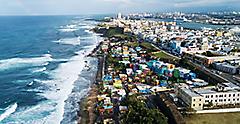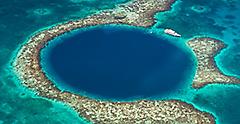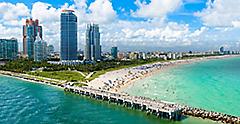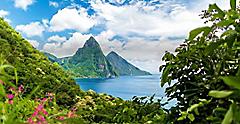
1. San Juan, Puerto Rico
Located on the north side of the island, San Juan is the cultural and commercial center of Puerto Rico where street art and creative criollo food abounds. It's the capital of Puerto Rico and worth exploring in-depth, but one can see plenty of the lively city in just one day.
To take advantage of this incredible destination during a short stop, first head to Old San Juan. The centuries-old town is known for its ancient forts, Castillo San Felipe del Morro (commonly referred to as "El Morro") and Fuerte San Cristóbal. Both have panoramic views of the turquoise ocean and historical items like cannons.
For a taste of San Juan's cultural side, head to Calle Loiza for award-winning murals, delicious seafood, creative cocktails and live music.The restaurants Tresbé, Azucena, Acapulco and Nonna all serve some of the best food in San Juan.
For a beach day, visit the Condado and Isla Verde areas to see the sandy stretches dotted with restaurants, bars and hotels. If you're looking for a more relaxed environment with beaches and great food, head to Loíza. The area of Piñones is famous for its alcapurrias, bacalaitos, piononos and empanadas. There are also a few new bars offering exotic drinks made with local fruits and rum.
Prices are very low, quality is high, and the views are unparalleled, making it the perfect affordable Caribbean vacation. There's also a boardwalk by the water, where you can catch ocean views, rent a bike or just stroll along and discover this slice of paradise on the north of the island.
2. Tortola, British Virgin Islands
Tortola is perhaps the quintessential British Virgin Island, representing everything people love about this part of the Caribbean: powdery sand beaches, succulent food and colorful neighborhoods. Tortola also features flowery hillsides, full-moon parties and pirate hideaways.
The island is the biggest and busiest of the British Virgin Islands, and while the capital, Road Town, is the most populated area on the island, it still manages to seem low-key. Walk along the coast through Cane Garden, Brewers Bay, Josiah's Bay or Smuggler's Cove for impressive views and transparent waters. Visit the Sage Mountain National Park, North Shore Shell Museum, Callwood Rum Distillery or the 1780 Lower Estate Sugar Works Museum to soak up Tortola's cultural heritage.
If you want to take advantage of Tortola's central location, you can visit other islands nearby during even a short visit. The trip by ferry from Tortola to Jost Van Dyke, for example, is only 25 minutes long and will give you the chance to explore a different destination that's famous for its beach bars, world-class snorkeling, clear water and white sand.
3. Puerto Plata, Dominican Republic
Puerto Plata is the oldest city in the northern Dominican Republic, famous for its lovely Malecón, leafy Parque Central and outdoor markets. Renovations have revitalized the area and it's now one of the most beautiful towns in the country. The multimillion-dollar refurbishment of the Malecón is especially impressive. Here you can visit Fortaleza de San Felipe, the fort that protected the city from pirate attacks and was later turned into a prison. The lighthouse was also restored and now likely looks like it once did when it guided the many ships sailing the Atlantic.
For a short visit to this Caribbean Port, make sure to hop on a teleferico, a cable car that travels through the town, for spectacular views of the coast. Another great hot spot is Casa Museo General Gregorio Luperon, the former home of independence leader Gregorio Luperon. The Victorian house is a beautiful pale green color and it's filled with period artifacts, photographs and paintings depicting Puerto Plata's modern history. Finally, don't miss Museo del Ambar, a cluster of colonial buildings that houses several amber exhibits. They include artifacts like a 50-million-year-old lizard.
4. Aruba
Aruba merges a variety of influences, including African, Dutch and Spanish, into a culture that's all its own. Dutch and Papiamento are the official languages, though English and Spanish are widely spoken as well. Cultural hot spots include the Unoca gallery, the Cas di Cultura Theatre and The National Archaeological Museum. Unusual spots like the Aloe Museum and the Arubian Taste Liqueur are also must-sees.
For locals arts and crafts, go to Cosecha, the stunning century-old building filled with handmade crafts located in the town of Oranjestad. The Cosecha Creative Center is a great place to learn a new craft and make a special souvenir.
For a rarer Aruba experience, skip the middle of the island and head to either end for rugged scenery, jungle views and quiet, photogenic beaches. There are underwater shipwrecks and airplane wrecks to discover, too. If you want some adrenaline, try kiteboarding or windsurfing.
Other quick stops include the natural pools inside Arikok National Wildlife Park and Eagle Beach, which is located in the resort area.
5. LABADEE
Nestled along Haiti’s northern coast, Labadee is an exciting private destination for Royal Caribbean guests with endless ways to relax and plenty of thrilling activities. Here, vibrant mountain ranges meet five sugar white sand beaches — each with its own unique appeal. If you can’t wait to soak up the sun, you’ll want to make Dragon’s Beach your first stop — it’s the closest beach upon arrival. Or sip on a signature Labadoozie frozen cocktail at the Floating Bar along the crescent-shaped shoreline of Adrenaline Beach — a must for anyone on a Labadee cruise. If you’re looking for max relaxation, kick back in a private bungalow at Nellie’s Beach with attendant service to keep the refreshments flowing. Shutter bugs can get the best bragworthy photos from the gorgeous lagoon-like bay of Columbus Cove. And those who cruise to Labadee in top-tier suites have exclusive access to Barefoot Beach Club featuring complimentary snorkeling equipment, floating beach mats, and spa treatments available at an additional cost. No matter which beach you choose, a postcard-perfect beach day awaits.
For adventure lovers, there are multiple ways to get an adrenaline fix. Catch sweeping views from Santa Maria’s lookout before racing down the mountainside on the alpine-style Dragon’s Tail Coaster℠. Dial up the thrills on a half-mile-long zip line ride over the ocean reaching speeds of up to 40 miles per hour. And if you’re traveling with kids or kids-at-heart, your cruise to Labadee is not complete without a stop at the inflatable Arawak Aqua Park featuring in-water trampolines, waterslides, and the only icebergs in the Caribbean. Pro tip: For a truly unique view of the island, go parasailing along the coast and take sightseeing to the next level.
Labadee also has a rich history and vibrant culture that reflects Spanish and French influence. Christopher Columbus discovered the island on his first voyage to the New World. And the destination has been captivating visitors ever since. Step into Le Village, an authentic Haitian teaching village where you can experience the sights, sounds and rhythms of everyday life on the island. Or visit the Artisan’s Village where you will find intricate handmade crafts such as carved wooden vases and colorful keepsake boxes made by local artist to remind you of your cruise to Labadee.
6. Curaçao
In Curaçao, the Dutch influence is the strongest of any Caribbean island and this can be particularly seen in its cuisine. Afro-Caribbean and Venezuelan influences are also seen in Curaçao's food and you'll taste them in dishes like arepa di pampuna. Try this and many more dishes at local restaurants like Trio Penotti, Brisa do Mar and Shelterrock.
There's a lot to do in Curaçao, including strolling by colonial buildings, taking in the art scene by stopping at a gallery and learning about its history from one of the many museums. You can also visit caves like the Blue Room on the West End or the Christoffel National Park as well as investigating the Landhuis Bloemhof Arts Center in Willemstad.
Many say Curaçao is like a slice of Europe in the Caribbean with its tropical beaches, white sand and hidden caves. Willemstad is also a UNESCO World Heritage Site and has pastel-colored buildings, flowery plazas and food stands. The town can be busy, but that's all part of getting to know local life in Curaçao.
7. Bonaire
Bonaire is for nature lovers, with plenty of beautiful vistas and intriguing animals to check out. Bonaire's national bird, the flamingo, can be seen at Gotomeer, so make sure to keep an eye out for the rose-colored creature. A must-see is the Washington Slagbaai Park, which includes a visitor center and museum.
Bonaire is famous for the number of beaches available on the island — 22 in total. The best beaches are Tera Kora, Klein and Sorobon.
Another great stop is the Donkey Sanctuary, which provides a sanctuary for the donkeys of Bonaire. You can do the tour by scooter, bike, car or walk through the park and photograph the donkeys. The tour guide will give you carrots to feed the donkeys, who have also been known to stick their heads inside cars looking for food.
Another sanctuary is Echo Parrot in the North End, which is home to one of Bonaire's most popular birds, the yellow-throated parrot. Known as the loquacious lora, the bird is endangered and therefore protected. There are only a few hundred birds left on the island, so Echo attempts to raise awareness of the bird's plight among locals and visitors.
8. Belize
Located on the east coast of South America, Belize is famous for its sultry jungles and adventure culture. For such a tiny island, Belize is jam-packed with things to do. The Belize Barrier Reef is perhaps the most sought-after adventure because the reef is the second-largest in the world. More than 100 types of coral can be seen here as well as hundreds of fish. On just a short swim, you're likely to see sea turtles and underwater caves.
Belize is also home to the Great Blue Hole, a giant marine sinkhole. This is a favorite spot for scuba divers and is a great place to spot rare species like the midnight parrotfish.
Back on land, you'll find a variety of jungles located inside national parks. Many of the parks have wildlife sanctuaries where you can see animals including cutter ants, howler monkeys, and even jaguars. In the parks, there are also lagoons, rivers and broadleaf forests.
Belize is also home to ancient ruins. Several archaeological sites date back to the time of the Maya in AD 250-1000. They're located in the Cayo and Toledo districts.
9. St. Croix, US Virgin Islands
In St. Croix, life moves a little slower than on other islands. The biggest of the United States Virgin Islands, St. Croix is twice as big as St. Thomas and pairs the lively pace of life on Charlotte Amalie with the relaxing options and natural wonders of St. John. You'll find dense forests, green hills and a blue-green coast which demonstrate how the island earned the nickname of the Garden of the Antilles. Many compare its topography to Hawaii's.
Don't miss the town of Christiansted, which includes an impressive fort by the water, colonial streets with many shops and restaurants serving creative cuisine. St. Croix is famous for its farming and you can get a taste of the wonderful island flavors in restaurants like Balter, Savant and Zion Modern Kitchen.
As soon as you get to shore, wander the streets of Frederiksted, where you can shop for crafts, try the local coffee and swim in the crystal-clear waters nearby. Then go to Point Udall for jaw-dropping views of the sea and the mountainside. There's a trail that takes you to different beaches, and white butterflies will likely accompany you.
Other great stops include the Cruzan Rum Distillery, Buck Island National Monument, the Captain Morgan Distillery and the beach at the Buccaneer Resort. The Estate Whim Museum is a beautifully restored estate with a windmill, cookhouse and the ruins of a sugar plantation.
St. Croix is one of the best Caribbean ports for those looking for authenticity, raw beauty and easy living. Be sure to explore beyond the port to discover the sights that aren't seen by every tourist.
















